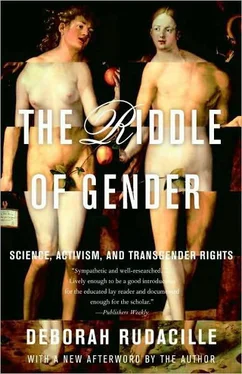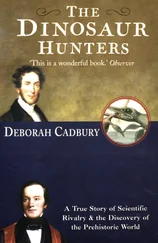I certify that Chevalier d’Eon lived with me for approximately three years, that I always considered him to be a woman; however, after his death and upon observation of the corpse discovered that he was a man. My wife certifies the same.
WILLIAM BOUNING, LONDON, 1810
I began the research for this book in the way that I approach every scientific subject that interests me, by searching the literature. I soon discovered that far from being a product of the modern world, gender variance has been documented across cultures and in every epoch of history. Male-bodied persons dressing and living as women and female-bodied persons dressing and living as men were known in ancient Greece and Rome, among Native American tribes prior to the arrival of Europeans, on the Indian subcontinent, in Africa, in Siberia, in eastern Europe, and in nearly every other indigenous society studied by anthropologists. According to historian Vern Bullough, “gender crossing is so ubiquitous, that genitalia by itself has never been a universal nor essential insignia of a lifelong gender. “In some of these cultures, cross-gendered persons were considered shamans gifted with extraordinary psychic powers, and they assumed special ceremonial roles. In many religions, the gods themselves can transform their sex at will, cross-dress, or are androgynous. Our Judeo-Christian heritage, founded on a belief in an exclusively male deity, has frowned on such gender fluidity; nonetheless, throughout the Middle Ages and even into the modern era, cross-dressing has been permitted and indeed celebrated at festivals, in clubs, and on the stage.
Moreover, the deathbed discovery of a gender reversal is a far more common occurrence in Western history than one might suspect. Many (though not all) of the persons whose names and stories are known to us today were born female and lived some or all of their lives as men. A few of the better-known individuals in this category include James Barry, British army physician and Inspector-General, died 1865; Charles Durkee Pankhurst, California stagecoach driver, died 1879; Murray Hall, Tammany Hall politician, died 1901; Jack Bee Garland, soldier in the Spanish-American War, died 1936; and Billy Tipton, jazz trumpeter, died 1989. Some of these people were married to women, who publicly expressed shock and amazement when their partners died and were found to be other than what friends and neighbors assumed them to be. It is impossible to know if this shock was real or was feigned for the benefit of a public that was not prepared to accept the alternative explanation—that the widow had lived happily with a female-bodied person who saw himself and was accepted by others (including his wife) as a man. The case of the Chevalier d’Eon, an eighteenth-century aristocrat whose gender was a source of considerable controversy during his lifetime, is a bit more complex, and because it became a public scandal, I will recount it more fully here.
Born in France in 1728, Charles-Genevieve Louis-Auguste-Andre-Timothee d’Eon de Beaumont lived forty-nine years as a man and thirty-four as a woman. Aristocrat, diplomat, soldier, and spy, d’Eon worked for the French government in both male and female roles, exhibiting such a chameleon-like ability to change from man to woman and back again that contemporary historians remain just as baffled as d’Eon’s peers by the chevalier’s metamorphoses. Traditional accounts suggest that d’Eon was dispatched on his first diplomatic mission to Russia in female garb to infiltrate the social circle of the Empress Elizabeth. After successfully carrying out this mission, d’Eon returned to France and assumed an unambiguously male role, becoming a captain of dragoons and fighting valiantly in the Seven Years’ War. Wounded in battle, d’Eon was named a Knight of St. Louis, and in 1762 was offered a diplomatic assignment at the British royal court. In a letter, the French king Louis XV congratulated the chevalier on his new post and wrote, “You have served me just as well in women’s clothing as you have in the clothes you are now wearing.”
While d’Eon was serving as minister plenipotentiary in London, his slight build and pretty features led many to believe that he was in fact a cross-dressed woman. People in England and France began placing wagers on his sex. The London Stock Exchange took bets on his gender, and the amount of money wagered on the chevalier purportedly rose to nearly two hundred thousand pounds in England alone. The fear of kidnapping began to haunt the chevalier, who suspected that those who had wagered large sums of money on the shape of his genitalia might seek to resolve the question by kidnapping and forced exposure. To avert a diplomatic crisis, King Louis XV of France sent a letter to George III of England, stating that d’Eon was a woman. Rather than calming public doubts, this letter created an even greater frenzy. Lawsuits were filed by losing bettors, doctors were called in to testify, and d’Eon was officially declared a woman by an English court. The chevalier responded to this public humiliation with dignity and defiance, writing to a friend, “I am what the hands of God have made me.”
In exchange for d’Eon’s agreement to live quietly as a woman, the French government granted the chevalier a generous pension. Although agreeing to abandon military dress, d’Eon requested permission to continue wearing the Cross of St. Louis, which as he wrote in a letter to the king “has always been a reward for bravery on the battlefield. Many officers have become priests or politicians and have worn this distinction over their new apparel. Therefore, I do not believe that a brave woman, who was raised in men’s clothing by her family, can be denied this right after she has carried out the dangerous duties in a praiseworthy fashion.” This request was granted and Mademoiselle d’Eon spent much of the remainder of her life residing in London with a female companion. When d’Eon died in 1810, five men who had known d’Eon were asked to examine the body and record their observations in order to settle definitively the question of d’Eon’s sex. All five witnesses testified that the body was anatomically male. The deceased’s female companion of many years professed herself shocked to discover that Mademoiselle d’Eon was not the woman she had always assumed her to be.
A generation after the Chevalier d’Eon’s death, a group of French doctors examined another puzzling corpse—that of a thirty-year-old railroad employee who had committed suicide in a squalid attic room in Paris. Abel Barbin, known for twenty-four years as Adelaide Herculine Barbin (and called Alexina), had been born with a body that appeared female. She was raised in a convent and became a teacher at an all-girl boarding school. Severe pain in her lower abdomen caused Alexina to seek medical assistance while employed at the school. The results of the doctor’s examination changed her life forever. “His hand was already slipping under my sheet and coming to a stop at the sensitive place. It pressed upon it several times, as if to find there the solution to a difficult problem. It did not leave off at that point!!! He had found the explanation that he was looking for! But it was easy to see that it exceeded all his expectations!”
The doctor had discovered Alexina’s undescended testicles and small penis, though he did not reveal this information to either Alexina or her employer, and instead advised the headmistress of the school to terminate the young schoolmistress. Alexina sought the advice of her bishop, who sent her to a second physician, a researcher, who prepared “a voluminous report, a masterpiece in the medical style, intended to ensure before the courts a petition for rectification.” In June i860, the birth register in Barbin’s home district was amended, and the female Alexina became the male Abel—by an act of law, not surgery. Though the body remained the same, the legal person was transformed from female to male. The scandal that ensued when the newspapers and the public discovered that a man had been teaching in an all-girl boarding school condemned Abel to “abandonment, to cold isolation.” His life as a man began in pain and confusion and plummeted rapidly into despair. He attempted to make a fresh start in Paris, but, impoverished and alone in a city that granted anonymity if not happiness, Abel was unable to make the transition from convent-bred woman to working man. He committed suicide at the age of thirty, overcome by feelings of isolation and desolation, the sense that he was absolutely alone in the world.
Читать дальше












